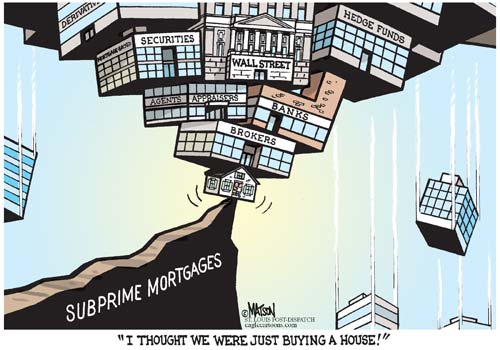– The Second Subprime Bubble Is Bursting, Gundlach Warns (ZeroHedge, Jan 24, 2014)
Back in the years just before the previous housing bubble burst (not to be confused with the current, even more acute one), one person did the math on subprime, realized that the housing – and credit bubble – collapse was imminent, and warned anyone who cared to listen – almost nobody did. That man was Kyle Bass, and because he had the guts to put the money where his mouth was, he made a lot of money. Fast forward to 2014 when subprime is all the rage again and the subprime bubble is bigger than ever: it may comes as a surprise to some that in 2013, subprime debt was one of the best performing fixed income instruments, returning a whopping 17% in a year when most other debt instruments generated negative returns. And this time, while Kyle Bass is busy – collecting nickels (each costing a dime) perhaps – it is someone else who has stepped into Bass’ Cassandra shoes: that someone is Jeff Gundlach.
From Bloomberg:
“These properties are rotting away,” Gundlach, 54, said last week on a conference call with investors, about homes stuck in foreclosure pipelines, adding that it could take six years to resolve defaulted loans made to the least creditworthy borrowers before the real-estate crash. Those residences are a sign of an uneven U.S. recovery, which has left blighted neighborhoods in cities from Los Angeles to Detroit and about 8 million borrowers still owing more on their mortgages than their homes are worth.
But while warning on yet another subprime implosion is nothing new, and many have done it in the past, why this time may be different and far more timely, is because seriously delinquent borrowers are literally soaring, up from 7% in 2012 to 32% currently!
A measure of losses on mortgage debt rose last quarter for the first time since 2011, Fitch Ratings said in a report yesterday. The reversal was driven by an aging pool of loans in the foreclosure process, particularly in states such as Florida and New Jersey which give added legal protections to homeowners against repossessions.
About 32 percent of seriously delinquent borrowers, those at least 90 days late, haven’t made a payment in more than four years, up 7 percent from the beginning of 2012, according to Fitch analyst Sean Nelson.
“These timelines could still increase for another year or so,” Nelson said, leading to even higher losses because of added legal and tax costs, and a greater potential for properties to deteriorate.
This means that the capacity of lenders to absorb losses is rapidly declining as inbound cashflows slow to a trickle. And not only that, but loss severities, or how much a lender will lose in case of default are also grinding higher:
Loss severities on subprime debt, tied to risky mortgages that inflated the housing bubble, increased to 75.9 percent from 74.1 in the last three months of the year. The severities — a measure of losses suffered on a liquidated loan — peaked at 77.1 percent in early 2012 from 12.8 percent at the end of 2006, during the property boom.
Gundlach isn’t the only one:
“In 2013, we were very bullish on subprime,” said Anup Agarwal, head of mortgage-backed and structured products at Pasadena, California-based Western Asset Management. “It was overall a big winner and you saw that reflected in prices.” Agarwal, whose firm managed $443 billion in fixed-income assets as of Sept. 30, has in the past six months turned more negative on subprime and started shifting money into Alt-A securities.
One William Street Capital Management LP, a hedge fund firm with $2.7 billion in assets, is expecting reduced losses as home prices continue to rise, according to a letter sent to investors this month. The investment firm said increased regulations have added to costs for firms that deal with troubled mortgages.
For subprime prices to make sense, recoveries must improve but won’t because of the backlog of loans, Gundlach said.
Gundlach’s take home message is simple:
“The housing market is softer than people think,” Gundlach said, pointing to a slowdown in mortgage refinancing, the time it’s taking to liquidate defaulted loans and shares of homebuilders that have dropped 14 percent since reaching a high in May. D.R. Horton Inc., the largest builder by revenue, fell 1.9 percent to $21.54 at 9:43 a.m. in New York trading, extending its drop since May to 22 percent.
The money manager has cautioned investors before about avoiding subprime. In 2012, he said investors can’t assume the “lines will head south” speaking about loss severities for loans and then last year, referred to the debt as being stubborn.
Alas, warnings in a centrally-planned system in which only what the head of the Fed does matters, are lost on everyone: such was the case with Bass, such will be the case with Gundlach for the simple reason that the ever fainter music is still playing, and those whose money comes from furiously shuffling worthless assets back and forth, must dance. Plus by now everyone knows that by the time people actually do listen, it is always too late.
